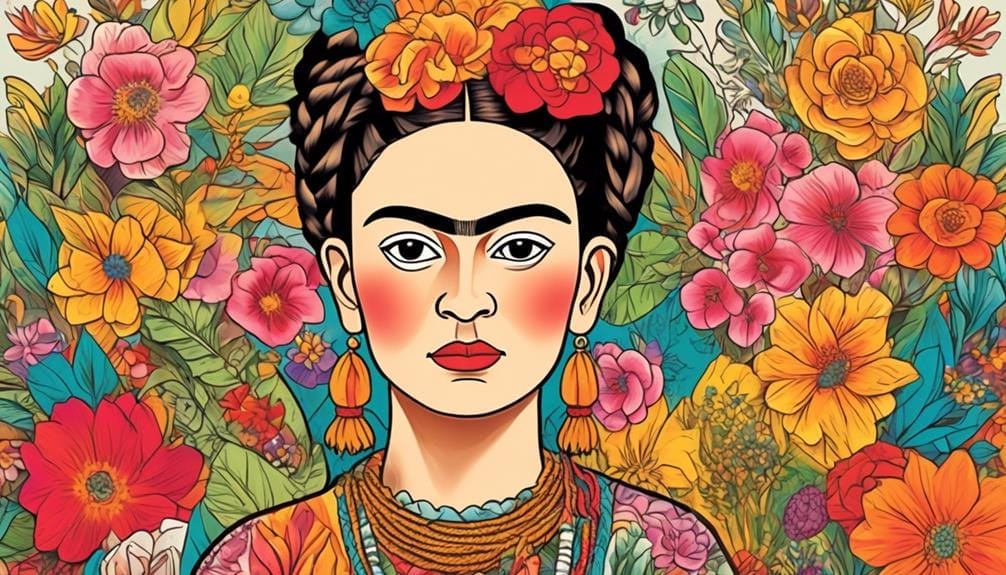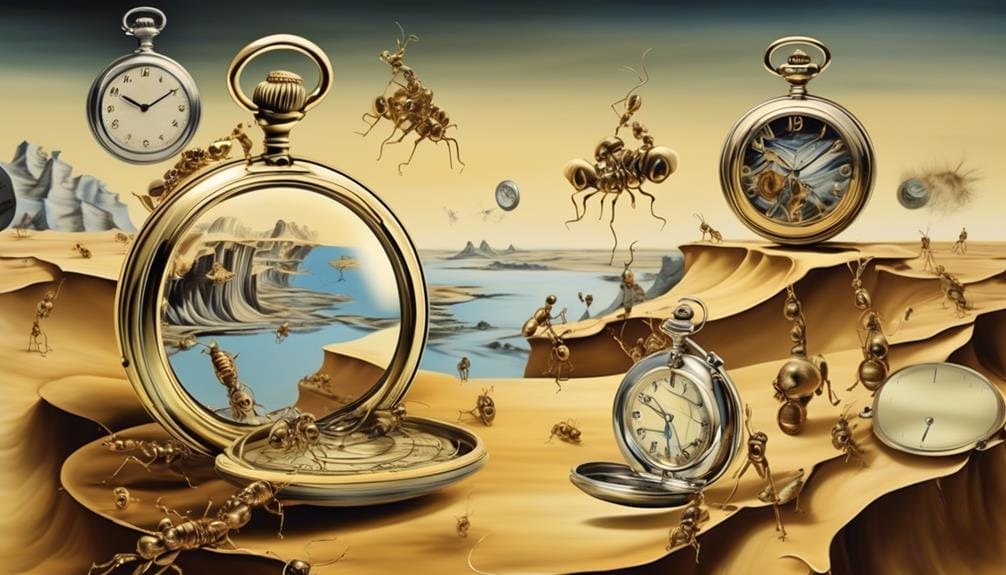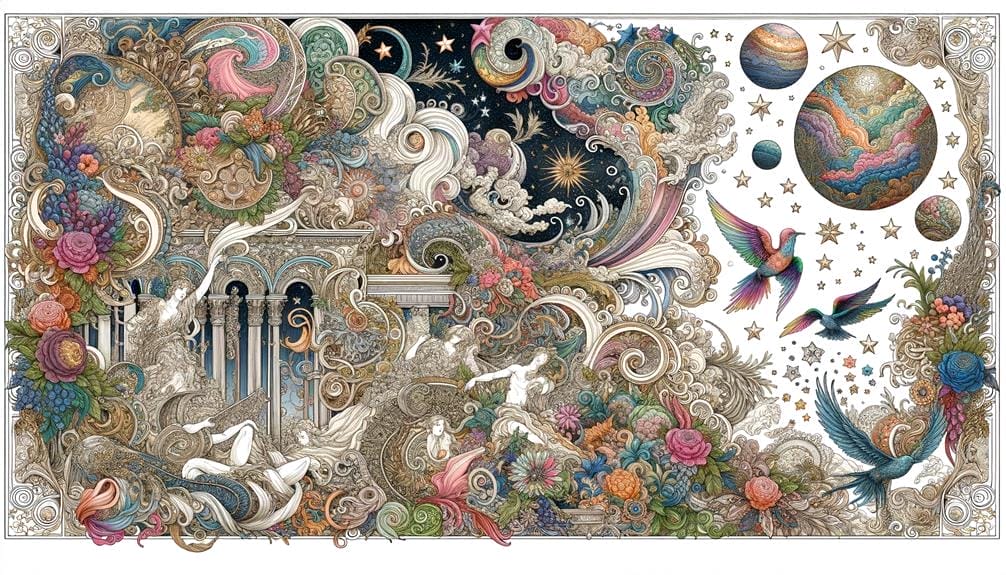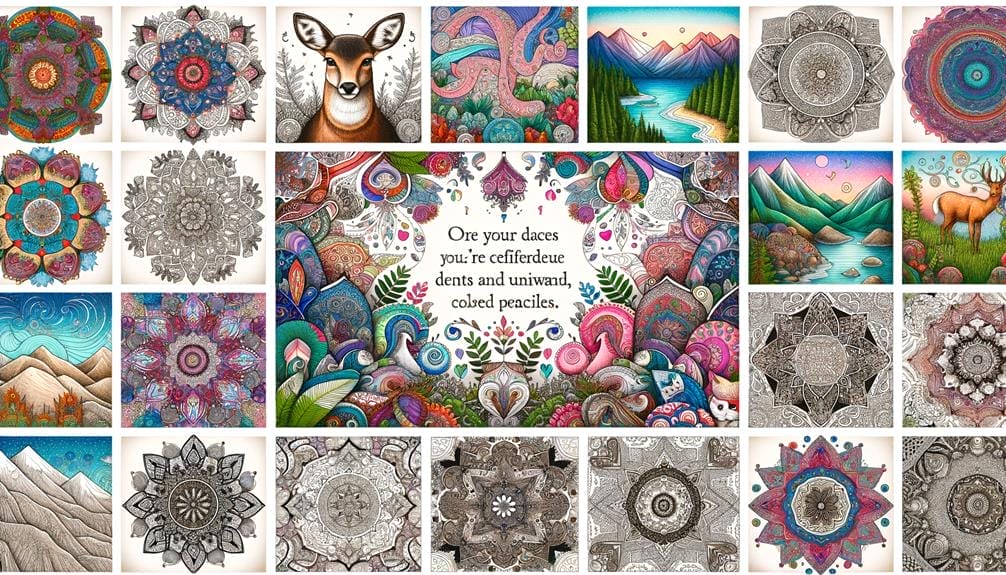Have you ever wondered what it would be like to add your own splash of color to Vincent van Gogh's iconic 'Starry Night' or Pablo Picasso's thought-provoking 'Guernica'? Famous Artwork Coloring Pages offer you the chance to do just that.
But it's not just about coloring between the lines; it's about immersing yourself in the world of renowned masterpieces and discovering the hidden stories and meanings behind each brushstroke.
So, grab your colored pencils and get ready to embark on a captivating journey through art history, where creativity meets relaxation and knowledge.
Key Takeaways
- Van Gogh's Starry Night is a captivating and renowned painting that uses bold colors and expressive brushwork to depict a swirling night sky.
- Da Vinci's Mona Lisa is a historically significant artwork that portrays individuality and human emotions through the use of sfumato and chiaroscuro.
- Kahlo's Self-Portraits are known for their unique style, vibrant colors, and incorporation of Mexican culture and symbolism, exploring themes of pain, identity, and the female experience.
- These famous artwork coloring pages provide an opportunity to engage with renowned masterpieces and appreciate the unique artistic techniques and themes showcased in each artwork.
Van Gogh's Starry Night
Van Gogh's Starry Night is undeniably one of the most captivating and renowned paintings in art history. This masterpiece, known for its bold use of color and expressive brushwork, depicts a swirling night sky with cypress trees and a small village. Van Gogh painted Starry Night during his time at the Saint-Paul-de-Mausole asylum in France, where he sought refuge from his inner demons.
The colors in Starry Night are vibrant and vibrant, with shades of blue, yellow, and green dominating the canvas. Van Gogh's use of color wasn't only a means of representation but also a way to convey his emotions. The swirling brushstrokes create a sense of movement and energy, adding to the painting's emotional intensity.
Starry Night is considered a masterpiece of Post-Impressionism, a movement that aimed to transcend the limitations of Impressionism by focusing on the artist's subjective expression. Van Gogh's unique style and innovative techniques have made him one of the most influential artists of all time.
If you're looking for a coloring page that captures the beauty and emotion of Starry Night, you're in luck. There are numerous coloring pages available online that allow you to recreate this iconic artwork in your own unique way. Coloring can be a therapeutic and relaxing activity, and what better way to unwind than by immersing yourself in the mesmerizing world of Van Gogh's Starry Night.
Da Vinci's Mona Lisa
When examining Da Vinci's Mona Lisa, it's impossible to ignore its historical significance and the artistic techniques employed by the master painter.
This iconic artwork not only showcases the beauty of the Renaissance period but also captures the enigmatic allure of its subject, Lisa Gherardini.
Da Vinci's use of sfumato, blending colors and tones seamlessly, adds depth and realism to the painting, while the serene landscape in the background enhances its overall composition.
Historical Significance of Mona Lisa
The historical significance of Leonardo da Vinci's Mona Lisa lies in its portrayal of Renaissance art, marking a pivotal shift towards a focus on the individual and human emotions rather than the traditional religious or mythological subjects. This masterpiece is more than just a painting; it's a symbol of artistic revolution and cultural transformation.
The Mona Lisa's enigmatic smile and the mysterious aura it exudes stir an emotional response in all who gaze upon it. Its theft in 1911 and subsequent return elevated its status, solidifying its place as a symbol of high art and cultural heritage.
Furthermore, the painting's influence extends beyond the art world, permeating popular culture with countless parodies, references, and reproductions. The Mona Lisa continues to captivate the imagination, provoking ongoing debates and theories surrounding its symbolism and the identity of the woman depicted.
To this day, Vincent Van Gogh's words ring true: 'The Mona Lisa is the most famous, the most visited, the most written about, the most sung about, the most parodied work of art in the world.'
Artistic Techniques Used
Da Vinci's artistic techniques in the Mona Lisa reveal a mastery of sfumato and chiaroscuro, elevating the painting to a level of visual brilliance and emotional depth.
Sfumato, a technique that creates a soft and seamless transition between colors and tones, is seen throughout the painting. This technique is particularly evident in the transitions of the Mona Lisa's skin tones and the landscape in the background. The use of sfumato also adds to the enigmatic quality of the painting. The soft blending of colors creates an elusive and mysterious atmosphere, contributing to the ambiguity of the Mona Lisa's expression.
Furthermore, Da Vinci's meticulous use of chiaroscuro, the play of light and shadow, adds depth and dimension to her enigmatic smile and gaze.
These artistic techniques make the Mona Lisa an ideal subject for coloring pages, allowing one to explore and appreciate the intricate details and nuances of the painting.
Kahlo's Self-Portraits

Kahlo's self-portraits showcase her unique style, incorporating vibrant colors and intricate details that add depth and symbolism to her personal narrative.
Through her introspective themes, she explores the complexities of pain, identity, and the female experience, offering a raw and emotional glimpse into her inner world.
Her incorporation of Mexican culture and symbolism reflects both her personal and cultural identity, making her self-portraits not only a reflection of herself but also an important contribution to art history.
Kahlo's Unique Style
Frida Kahlo's self-portraits, characterized by their incorporation of symbolic imagery, vibrant colors, and surreal elements, offer a deeply personal and emotionally charged glimpse into the artist's inner world. Kahlo's unique style in her self-portraits captures the complexity of her experiences and emotions, leaving a lasting impact on viewers.
Here are three key aspects of Kahlo's style that evoke a strong emotional response:
- Symbolic imagery: Kahlo often used symbols such as animals, plants, and objects to represent her feelings of pain, identity, and strength. These symbols create a visual language that speaks directly to the viewer's emotions.
- Vibrant colors: Kahlo's use of bold and vibrant colors adds intensity and energy to her self-portraits. The contrasting hues convey the depth of her emotions, from joy to sorrow, allowing viewers to connect with her on a visceral level.
- Surreal elements: By incorporating surreal and dreamlike elements into her self-portraits, Kahlo blurs the boundaries between reality and imagination. This technique invites viewers into her inner world, where they can explore the complexities of her experiences and emotions.
Symbolism in Self-Portraits
The depth of emotion conveyed in Frida Kahlo's self-portraits is further heightened through her masterful use of symbolic imagery. Kahlo's self-portraits serve as a powerful exploration of symbolism, allowing her to express her emotions and experiences in a deeply personal and introspective way. Through the use of vibrant colors, intricate details, and symbolic elements, Kahlo creates a visual language that goes beyond mere representation. Her self-portraits become a window into her inner world, offering a profound insight into her pain, resilience, and identity. Cultural representation is also a significant aspect of Kahlo's self-portraits, as she often incorporates traditional Mexican elements and indigenous symbolism. By combining emotional expression, symbolism, and cultural representation, Kahlo's self-portraits become a testament to the complexity of the human experience.
Symbolism Exploration | Emotional Expression | Cultural Representation
— | — | —
Kahlo's self-portraits incorporate symbolic elements representing her physical and emotional struggles | The use of vibrant colors and intricate details conveys deeper meanings and personal narratives | Kahlo often features traditional Mexican elements, reflecting her cultural identity and heritage
Symbolism in Kahlo's self-portraits explores themes of pain, resilience, and identity | Through symbolic imagery, Kahlo's self-portraits reflect her introspection and the complexities of her life experiences | Indigenous symbolism is also present, further emphasizing her cultural representation
Impact on Art History
Frida Kahlo's self-portraits have left an indelible mark on art history, revolutionizing the portrayal of personal experiences and challenging traditional norms within the art world. Her introspective and often surreal self-portraits have challenged conventions by delving into the depths of her own psyche, providing a raw and unfiltered exploration of her emotional and psychological experiences. Through her work, Kahlo hasn't only redefined the representation of the female experience in art but also opened up avenues for cultural representation.
Her self-portraits are infused with personal symbolism and cultural references, allowing viewers to delve into the complexities of her identity and cultural heritage. By fearlessly delving into her own pain, Kahlo has inspired artists to explore their own inner worlds and personal narratives, paving the way for a more introspective and emotionally charged art form.
- Kahlo's self-portraits challenge the notion that art should be detached from personal experiences, inviting viewers to connect on a deeply emotional level.
- Her portrayal of femininity, pain, and resilience breaks free from societal expectations, empowering women to embrace their own unique experiences and emotions.
- Through her exploration of personal and cultural identity, Kahlo challenges the dominant narratives of the art world and expands the representation of diverse voices and experiences.
Monet's Water Lilies

Monet's Water Lilies series, consisting of approximately 250 oil paintings, showcases Claude Monet's innovative approach to capturing the ever-changing qualities of nature through vibrant colors and loose brushwork. These artworks, depicting Monet's flower garden at Giverny and the Japanese bridge over the water lily pond, are a testament to his fascination with light, color, and the transitory nature of the natural world.
Monet's Water Lilies is not just a collection of beautiful paintings; it is also a symbol of the artist's deep connection with nature. The water lilies themselves hold symbolic meaning, representing tranquility, purity, and the cycle of life. Monet's use of color in these paintings is extraordinary, as he skillfully captures the play of light on the water's surface and the reflections of the surrounding landscape. The vibrant hues and bold brushwork create an immersive experience, drawing viewers into the serene and ethereal realm of the water lily pond.
The influence of Monet's Water Lilies series on modern art cannot be overstated. The loose brushwork and emphasis on capturing the fleeting qualities of nature were revolutionary at the time and paved the way for the development of Impressionism as an artistic movement. Monet's innovative approach to depicting light and color influenced countless artists, challenging traditional notions of representation and inspiring a new way of seeing the world.
| Symbolism in Water Lilies | Use of Color in Water Lilies | Influence on Modern Art |
|---|---|---|
| Tranquility, purity, and the cycle of life | Vibrant hues and bold brushwork | Paved the way for Impressionism, influenced countless artists |
Picasso's Guernica
When examining Picasso's Guernica, you'll find a multitude of symbolism embedded within the artwork. The painting serves as a powerful critique of the devastating consequences of war, with each element carefully chosen to convey a specific message.
From the distorted human and animal forms to the stark contrast of light and dark, Picasso expertly captures the chaos and suffering caused by conflict.
Furthermore, the impact of Guernica can't be overstated, as it continues to resonate with viewers and inspire conversations about the horrors of war and the importance of peace.
Symbolism in Guernica
In Picasso's Guernica, the powerful symbolism vividly portrays the horrors of war and the immense suffering endured by both civilians and animals affected by the Spanish Civil War bombing. The symbolism in Guernica is rich with analysis, interpretation, and significance. Here are three key elements that evoke a strong emotional response:
- The bull and the horse: These animals represent the people and creatures caught in the devastating crossfire of war. Their presence emphasizes the indiscriminate nature of violence and the shared suffering experienced by all.
- The shattered sword: This symbolizes the defeat and destruction caused by conflict. It serves as a stark reminder of the devastating consequences of war and the futility of violence as a means to an end.
- The agonized figures and distorted shapes: These portray the pain, fear, and chaos experienced during wartime. The contorted bodies and anguished expressions convey the immense human suffering and the psychological toll of conflict.
Through these powerful symbols, Guernica captures the collective trauma and devastation caused by war, urging viewers to reflect on the profound consequences of violence.
Impact of Guernica
The impact of Picasso's masterpiece, Guernica, reverberates through history as a poignant and enduring condemnation of the atrocities of war. Set in the historical context of the Spanish Civil War, the painting captures the emotional impact of the bombing of Guernica by German and Italian air forces.
Through his artistic techniques, Picasso creates a visual narrative of horror and despair. The monumental size of the painting, measuring 11 feet tall and 25.6 feet wide, intensifies its impact, engulfing the viewer in the scale of destruction. The dismembered bodies, anguished figures, and animals in distress serve as powerful symbols of the human suffering caused by war.
Guernica's ability to evoke strong emotions and provoke reflection continues to make it a significant work of art, reminding us of the devastating consequences of conflict.
Dali's The Persistence of Memory

Dali's surrealist masterpiece, 'The Persistence of Memory,' captivates viewers with its dreamlike depiction of melting clocks draped over various objects. This iconic painting, created during the Surrealist movement, has been the subject of much interpretation analysis. The symbolism of the melting clocks is particularly intriguing.
- The melting clocks in 'The Persistence of Memory' evoke a sense of time's fluidity and the fleeting nature of existence. They challenge our conventional understanding of time as a fixed and measurable entity, inviting us to question our own perception of reality.
- The soft, melting forms of the clocks create an atmosphere of uncertainty and introspection. They suggest a world where time is malleable and subjective, where the boundaries between past, present, and future blur and merge.
- The desolate landscape in the background adds to the painting's enigmatic quality. It enhances the feeling of timelessness, as if the scene exists outside of any specific era or context. This desolation also serves as a metaphor for the fragility of memory and the transience of human existence.
Botticelli's The Birth of Venus
With its delicate portrayal of the female form and its ethereal beauty, Botticelli's The Birth of Venus is a renowned masterpiece of the Early Renaissance period. The painting is rich in symbolism, with each element carefully chosen to convey deeper meanings.
The depiction of Venus emerging from the sea on a shell symbolizes her birth, as told in classical mythology. The shell itself represents the female reproductive organ, alluding to the power of female fertility and creation. Botticelli's use of line and form in the painting reflects the influence of classical sculptures and ancient Greek art, showcasing his admiration for the ideals of beauty and harmony.
The Birth of Venus has had a significant influence on modern art, inspiring countless artists with its ethereal aesthetic and timeless subject matter. Its historical context is also important to consider, as it was created during a period of great artistic and intellectual revival in Florence.
Botticelli's masterpiece stands as a testament to the beauty and creativity of the Renaissance era, while also serving as a reminder of the enduring power of classical mythology.
Hokusai's The Great Wave off Kanagawa
Hokusai's woodblock print, The Great Wave off Kanagawa, captures the raw power and beauty of nature in a mesmerizing composition. This iconic artwork has a deep symbolism that resonates with viewers, evoking a range of emotions.
The towering wave symbolizes the overwhelming force of nature, conveying a sense of awe and power. It reminds us of the insignificance of human existence in the face of nature's might.
The boats struggling against the wave represent the resilience and determination of humanity in the face of adversity. They serve as a reminder of the constant struggle for survival and the indomitable spirit of the human race.
The presence of Mount Fuji in the background adds a sense of stability and serenity to the chaotic scene. It represents the enduring nature of the world and serves as a symbol of national identity for the Japanese people.
Hokusai's masterpiece has had a profound influence on modern art, inspiring countless artists with its dynamic composition and use of contrast. It has become a symbol of Japanese culture and is recognized worldwide.
The Great Wave off Kanagawa isn't just a stunning artwork, but also a reflection of the cultural significance and artistic brilliance of Hokusai's era.
Warhol's Campbell's Soup Cans
Warhol's Campbell's Soup Cans series, created in 1962, revolutionized the art world by challenging traditional notions of what constitutes fine art. This iconic series is a prime example of Warhol's artistic influence and his significant role in the Pop Art movement. Warhol's use of repetition in these paintings is a key aspect of their impact and success.
The Campbell's Soup Cans series consists of 32 paintings, each depicting a different flavor of the popular canned soup. By elevating this mass-produced object to the status of a fine art masterpiece, Warhol blurred the boundaries between commercial and high art. This bold move questioned the elitism and exclusivity that had long been associated with the art world.
Warhol's fascination with consumer culture is evident in his Campbell's Soup Cans. The repetitive and uniform composition of the paintings reflects his interest in mass production and the prevalence of consumer goods in American society. By reproducing the same image multiple times, Warhol highlighted the ubiquity and homogeneity of these products, while also celebrating their visual appeal.
The Campbell's Soup Cans series not only challenged the traditional definitions of art but also paved the way for a new era of artistic expression. Warhol's emphasis on popular culture and his use of everyday objects as subjects influenced countless artists and shaped the trajectory of the Pop Art movement. His legacy continues to resonate in contemporary art, proving that his revolutionary approach to art-making was truly ahead of its time.
Munch's The Scream
The legacy of Warhol's Campbell's Soup Cans series continues to inspire and influence artists, as seen in the emotional intensity and psychological depth captured in Edvard Munch's iconic painting, The Scream. Munch's masterpiece is a profound exploration of human emotion, resonating with viewers on a deeply personal level.
Here are three aspects of The Scream that evoke a powerful emotional response:
- Symbolism in The Scream: The painting's distorted figure, with its wide-open mouth and hollow eyes, symbolizes the universal experience of anxiety and existential dread. It represents the overwhelming sense of despair that can consume individuals in moments of crisis. Munch's use of vivid, swirling colors in the background further enhances the chaotic and unsettling atmosphere.
- Emotional impact of The Scream: The painting's raw and intense expression of fear and anguish strikes a chord with viewers. The contorted face and the silent scream resonate with the viewer's own experiences of anxiety and distress, tapping into deep-seated emotions. It serves as a reminder of the fragility of the human condition and the universal nature of suffering.
- Influence on modern art: The Scream has had a profound impact on modern art, inspiring numerous artists to explore themes of existentialism and the human psyche. Its expressionistic style and emotional depth have influenced movements such as Expressionism and Abstract Expressionism. The painting's ability to convey intense emotions through visual means has become a benchmark for artists seeking to evoke a powerful response from their audience.
Vermeer's Girl With a Pearl Earring
Johannes Vermeer's masterpiece, Girl With a Pearl Earring, captivates viewers with its enigmatic portrayal of a young girl adorned with a luminous earring, showcasing Vermeer's mastery of light and shadow. Vermeer's use of light in this painting is remarkable, as he skillfully captures the interplay between light and darkness. The soft, diffused light illuminates the girl's face, creating a sense of depth and realism. This technique not only enhances the overall composition but also draws attention to the focal point of the painting, the girl's captivating gaze.
The symbolism behind the earring in Girl With a Pearl Earring adds another layer of intrigue to the artwork. The earring, with its luminosity and placement, represents wealth and beauty. It serves as a visual metaphor for the girl's allure and mystery. Vermeer's deliberate decision to feature this earring prominently in the painting suggests that there's more to the girl than meets the eye. It invites viewers to contemplate the significance of her expression and the story behind her enigmatic gaze.
Vermeer's Girl With a Pearl Earring has had a significant impact on art history. It's considered one of the most iconic artworks in history, inspiring countless artists and influencing the development of portraiture. The painting's popularity has only grown over the centuries, capturing the imagination of viewers and sparking speculation about the identity of the girl and the narrative behind the painting. Vermeer's meticulous attention to detail and his ability to capture the essence of his subjects continue to resonate with artists and art enthusiasts alike.
Frequently Asked Questions
What Famous Artists Use Color Theory?
Vincent van Gogh, Piet Mondrian, and M.C. Escher are some famous artists who extensively use color theory. They understand the impact of color in impressionism and utilize it to evoke emotions. Color theory in abstract art helps them create visually impactful and psychologically engaging artwork.
What Famous Artist Used Bright Colors?
Vincent Van Gogh, a famous artist known for his vibrant colors in impressionism, utilized bright colors to evoke emotions. His bold color choices in abstract art reflected his inner struggles and influenced modern art.
Is Selling Coloring Pages Profitable?
Selling coloring pages can be profitable due to the wide appeal of creative and stress-relieving activities. The coloring page market offers opportunities to target various age groups, maximizing profitability.
What Is the History of Coloring Pages?
Coloring pages have a fascinating history, dating back to the late 19th century. They were created as educational tools, teaching kids geography, history, and culture. Today, they offer therapeutic benefits and cultural significance.
Conclusion
In conclusion, exploring and coloring famous artwork pages offers a captivating journey through the world of art history. By immersing oneself in the intricate details of masterpieces like Vincent van Gogh's 'Starry Night' or Pablo Picasso's 'Guernica,' individuals can unleash their creativity and gain a deeper understanding of these renowned works.
It's like stepping into a vibrant canvas and experiencing the art firsthand. So grab your colored pencils and let your imagination soar as you bring these iconic artworks to life. After all, art is meant to be enjoyed and appreciated in all its colorful glory.


